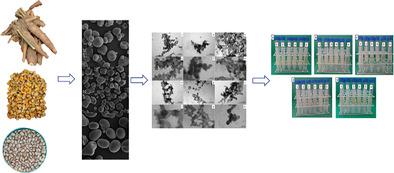Our official English website, www.x-mol.net, welcomes your feedback! (Note: you will need to create a separate account there.)
Pickering Emulsions Produced with Starch Nanocrystals from Cassava (Manihot esculenta Crantz), Beans (Phaseolus vulgaris L.), and Corn (Zea mays L.)
Starch ( IF 2.3 ) Pub Date : 2020-04-13 , DOI: 10.1002/star.201900326 Taiana H Gomes Daniel 1 , Ana C Bedin 1 , Éder Carlos F Souza 2 , Luiz Gustavo Lacerda 1 , Ivo Mottin Demiate 1
Starch ( IF 2.3 ) Pub Date : 2020-04-13 , DOI: 10.1002/star.201900326 Taiana H Gomes Daniel 1 , Ana C Bedin 1 , Éder Carlos F Souza 2 , Luiz Gustavo Lacerda 1 , Ivo Mottin Demiate 1
Affiliation

|
The objective of this study is to produce Pickering emulsions with starch nanocrystals from different starch sources. Bean starch is less susceptible to hydrolysis, followed by corn, and cassava starches. In both botanical sources the acid hydrolysis greatly reduce the amylose content in the nanoparticles. Oxidation increases the zeta potential of all the nanocrystals. In addition, the value of polydispersity decreases. A peak at 1,735 cm−1 is detected by means of mid‐infrared spectroscopy, which is characteristic of the free carboxyl group (acid form—COOH), expected on oxidized starches. Cassava and corn starches as well as their nanocrystals have an A‐type crystallinity pattern. For bean starch, the original CA‐type crystallinity pattern remains for the non‐oxidized nanocrystals but changes to A‐type after oxidation. After hydrolysis, the relative crystallinity increases for nanocrystals, but decreases after oxidation. The exception is for bean starch that results in oxidized nanocrystals with higher relative crystallinity. In general, the oxidation of nanocrystals improves their emulsification index. The emulsification index is higher for the emulsions with larger amounts of oil, even though the average diameter of the droplets increases in this situation.
中文翻译:

用木薯淀粉(Manihot esculenta Crantz),豆类(Phaseolus vulgaris L.)和玉米(Zea mays L.)生产的淀粉纳米晶体生产的皮克林乳液
这项研究的目的是从不同的淀粉来源生产具有淀粉纳米晶体的Pickering乳液。豆淀粉较不易水解,其次是玉米和木薯淀粉。在两种植物来源中,酸水解都大大降低了纳米颗粒中的直链淀粉含量。氧化增加了所有纳米晶体的ζ电势。另外,多分散性的值降低。通过中红外光谱在1735 cm -1处检测到一个峰,该峰是氧化淀粉预期的游离羧基(酸形式-COOH)的特征。木薯和玉米淀粉及其纳米晶体具有A型结晶度模式。对于豆淀粉,原C A对于未氧化的纳米晶体,其结晶类型保留不变,但在氧化后变为A型。水解后,纳米晶体的相对结晶度增加,但在氧化后降低。豆淀粉除外,它会导致氧化的纳米晶体具有较高的相对结晶度。通常,纳米晶体的氧化改善了它们的乳化指数。即使油滴的平均直径在这种情况下增加,对于油量较大的乳液,乳化指数也较高。
更新日期:2020-04-13
中文翻译:

用木薯淀粉(Manihot esculenta Crantz),豆类(Phaseolus vulgaris L.)和玉米(Zea mays L.)生产的淀粉纳米晶体生产的皮克林乳液
这项研究的目的是从不同的淀粉来源生产具有淀粉纳米晶体的Pickering乳液。豆淀粉较不易水解,其次是玉米和木薯淀粉。在两种植物来源中,酸水解都大大降低了纳米颗粒中的直链淀粉含量。氧化增加了所有纳米晶体的ζ电势。另外,多分散性的值降低。通过中红外光谱在1735 cm -1处检测到一个峰,该峰是氧化淀粉预期的游离羧基(酸形式-COOH)的特征。木薯和玉米淀粉及其纳米晶体具有A型结晶度模式。对于豆淀粉,原C A对于未氧化的纳米晶体,其结晶类型保留不变,但在氧化后变为A型。水解后,纳米晶体的相对结晶度增加,但在氧化后降低。豆淀粉除外,它会导致氧化的纳米晶体具有较高的相对结晶度。通常,纳米晶体的氧化改善了它们的乳化指数。即使油滴的平均直径在这种情况下增加,对于油量较大的乳液,乳化指数也较高。


























 京公网安备 11010802027423号
京公网安备 11010802027423号